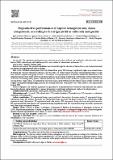Por favor, use este identificador para citar o enlazar a este item:
http://hdl.handle.net/10261/314195COMPARTIR / EXPORTAR:
 SHARE SHARE
 CORE
BASE CORE
BASE
|
|
| Visualizar otros formatos: MARC | Dublin Core | RDF | ORE | MODS | METS | DIDL | DATACITE | |

| Título: | Reproductive performance of captive Senegalese sole, Solea senegalensis, according to the origin (Wild or cultured) and gender. |
Autor: | Martín, I.; Carazo, I.; Rasines, Inmaculada; Rodríguez-Calvo, Concepción; Fernández, R.; Martínez, P.; Norambuena, F.; Chereguini-Fernández-Maquieira, María del Olvido; Duncan, N. | Palabras clave: | Centro Oceanográfico de Santander Acuicultura Reproduction natural spawn Behaviour parental contribution |
Fecha de publicación: | 2019 | Editor: | CSIC - Instituto Nacional de Investigación y Tecnología Agraria y Alimentaria (INIA) | Resumen: | Aim of study: The reproductive performance over a five year period in three different sole broodstocks: wild males with cultured females (WM), cultured males with wild females (CM), and a control of cultured males and females (C). Area of study: Cantabria, Northern Spain. Material and methods: The parental contribution was evaluated through the allocation of hatched larvae and a behavioural study was performed using underwater video recordings. Main results: Fertilized natural spawns were only obtained from group WM showing a significantly higher mean annual volume of floating eggs compared with groups CM and C. Over the entire 5-yr a higher number of spawns, total and floating volumes of eggs were obtained compared with groups CM and C. The analysis of four polymorphic microsatellites enabled the identification of the individuals involved in the fertile spawns by parental assignment. The percentage of individuals contributing to spawns ranged between 56.3% and 75% showing fidelity patterns. However between 46.2% and 68.6% of the contribution to production was a result of the crossing of three single couples. According to the behaviour analysis, group WM presented the highest peak of activity at 20:00 h and a higher activity profile during the night, moreover, the courtship behaviours “swim follow” and “swim followed”, were only recorded in group WM. Research highlights: The study has importance for aquaculture as it demonstrated how broodstocks with wild males and cultured females had adequate egg production for a commercial operation to supply eggs and implement single sex breeding programs. | URI: | http://hdl.handle.net/10261/314195 | DOI: | 10.5424/sjar/2019174-14953 | ISSN: | 2171-9292 |
| Aparece en las colecciones: | (IEO) Artículos |
Ficheros en este ítem:
| Fichero | Descripción | Tamaño | Formato | |
|---|---|---|---|---|
| 14953-Article Text-61184-1-10-20200131.pdf | 515,88 kB | Adobe PDF |  Visualizar/Abrir |
CORE Recommender
SCOPUSTM
Citations
11
checked on 08-may-2024
WEB OF SCIENCETM
Citations
11
checked on 22-feb-2024
Page view(s)
16
checked on 10-may-2024
Download(s)
29
checked on 10-may-2024
Google ScholarTM
Check
Altmetric
Altmetric
Este item está licenciado bajo una Licencia Creative Commons

